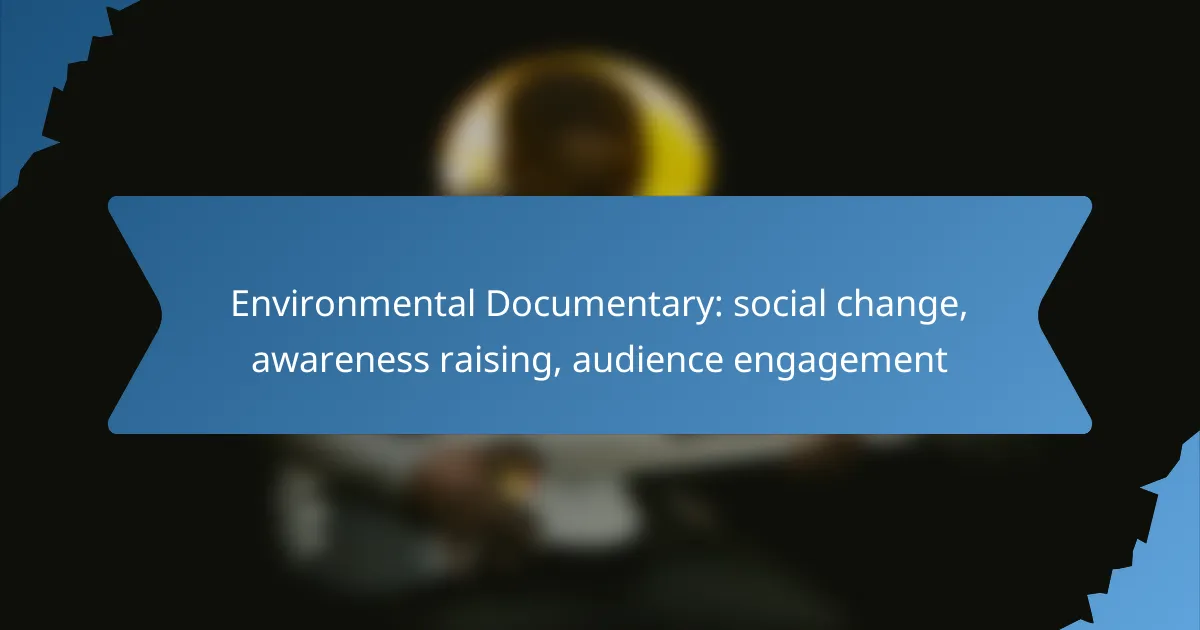Environmental documentaries in the UK serve as powerful catalysts for social change, effectively raising awareness about critical ecological issues and motivating audiences to take action. By utilizing compelling storytelling and visual narratives, these films engage viewers on an emotional level, encouraging them to adopt sustainable practices and advocate for a healthier planet.
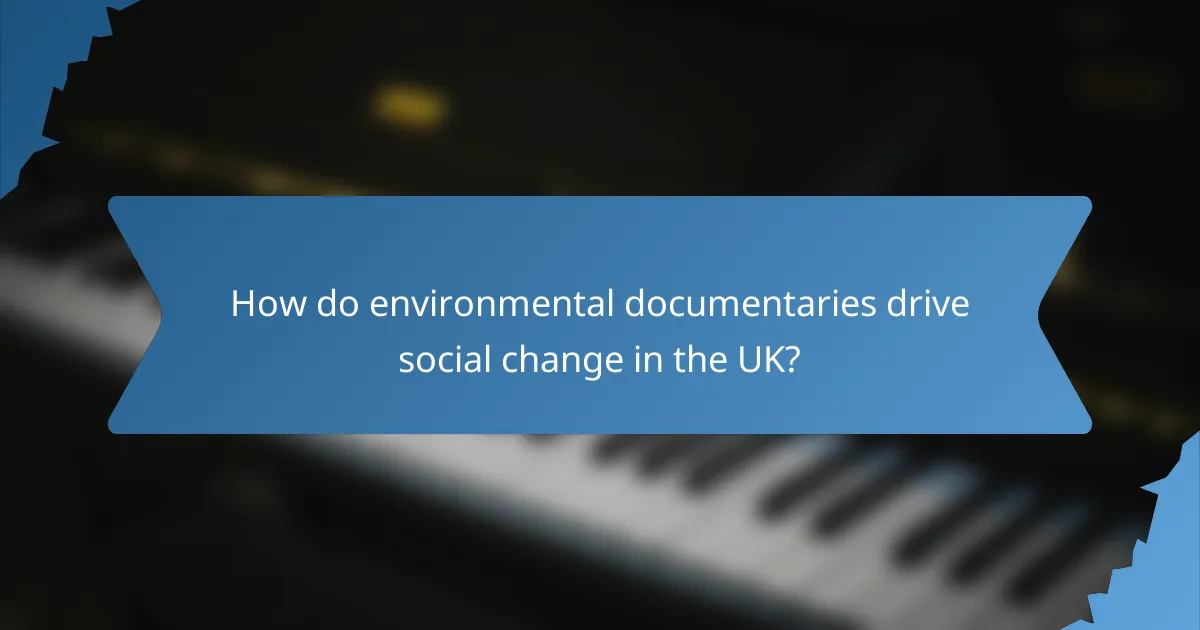
How do environmental documentaries drive social change in the UK?
Environmental documentaries in the UK play a crucial role in driving social change by raising awareness about pressing ecological issues and inspiring audiences to take action. Through compelling storytelling and visual narratives, these films engage viewers emotionally, prompting them to reconsider their behaviors and advocate for sustainable practices.
Case studies of impactful films
Several environmental documentaries have significantly influenced public perception and behavior in the UK. For instance, “Before the Flood” highlights the urgent need for climate action, leading to increased discussions on renewable energy policies. Another notable film, “Our Planet,” showcases the beauty of nature while emphasizing the consequences of climate change, motivating viewers to support conservation efforts.
These films often spark community screenings and discussions, amplifying their impact. By sharing personal stories and local examples, they resonate with audiences, making the issues more relatable and actionable.
Community engagement initiatives
Community engagement initiatives linked to environmental documentaries often involve local screenings, workshops, and discussions that encourage active participation. Organizations frequently partner with filmmakers to host events that not only showcase the films but also facilitate conversations about local environmental challenges.
For example, initiatives like “Film and Food” events combine screenings with local cuisine, fostering a sense of community while addressing sustainability in food systems. These gatherings can lead to the formation of local action groups focused on specific environmental issues, enhancing collective efforts for change.
Policy influence through storytelling
Environmental documentaries can influence policy by highlighting critical issues and showcasing potential solutions. Policymakers often use insights from these films to inform legislation and public initiatives. Documentaries that effectively illustrate the impacts of pollution or climate change can lead to stronger regulations and funding for environmental programs.
Moreover, the emotional narratives presented in these films can mobilize public support, pressuring governments to act. Engaging storytelling can transform complex scientific data into relatable stories, making it easier for the public and decision-makers to understand the urgency of environmental issues.

What are effective strategies for raising awareness through documentaries?
Effective strategies for raising awareness through documentaries include leveraging social media, collaborating with NGOs, and engaging in targeted outreach to specific audiences. These methods enhance visibility and foster community involvement, driving social change.
Utilizing social media platforms
Social media platforms are powerful tools for raising awareness about documentaries. By sharing trailers, behind-the-scenes content, and engaging posts, filmmakers can reach a broad audience quickly. Platforms like Instagram, Facebook, and Twitter allow for interactive discussions, which can deepen viewer connection and commitment to the cause.
To maximize impact, consider creating shareable content that encourages viewers to spread the message. Hashtags related to the documentary’s themes can help increase visibility and foster community engagement. Regular updates and live Q&A sessions can also keep the audience engaged and informed.
Collaborations with NGOs
Partnering with non-governmental organizations (NGOs) can significantly enhance the reach and credibility of a documentary. NGOs often have established networks and resources that can help promote the film to targeted audiences who are already interested in related issues. This collaboration can include joint events, screenings, and educational programs.
When collaborating, ensure that the goals of the documentary align with the NGO’s mission. This synergy can lead to more effective campaigns and a stronger impact on social change. Additionally, NGOs can provide valuable insights and data that enrich the documentary’s content.
Targeted audience outreach
Targeted audience outreach involves identifying and engaging specific groups that are most likely to resonate with the documentary’s themes. This can include community organizations, educational institutions, and activist groups. Tailoring messages and outreach strategies to these audiences can enhance engagement and foster a sense of ownership over the issues presented.
Consider hosting screenings followed by discussions or workshops that invite audience participation. Providing educational materials and resources can also empower viewers to take action. Utilizing surveys or feedback forms can help refine outreach strategies for future projects, ensuring they effectively reach and engage the intended audience.
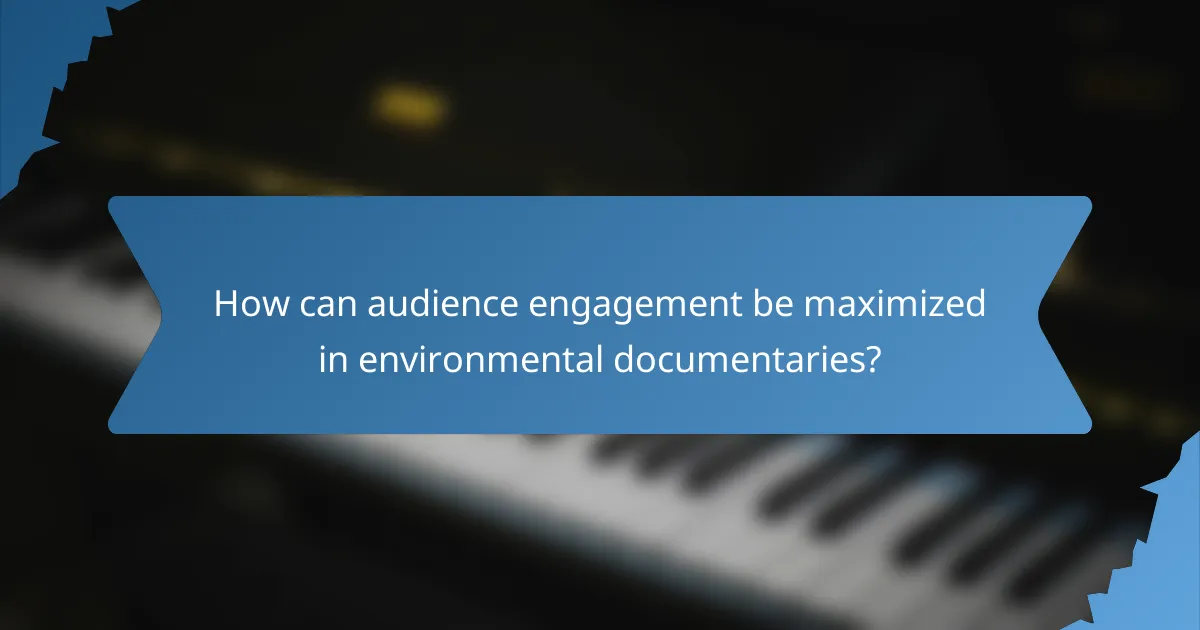
How can audience engagement be maximized in environmental documentaries?
Maximizing audience engagement in environmental documentaries involves creating interactive experiences that encourage participation and feedback. By fostering a sense of community and involvement, filmmakers can enhance awareness and drive social change effectively.
Interactive screenings and discussions
Interactive screenings allow audiences to engage directly with the content through Q&A sessions, live polls, or facilitated discussions. These formats encourage viewers to express their thoughts and connect with the material on a personal level.
Consider hosting events in local community centers or schools where audiences can discuss the documentary’s themes and implications. This approach not only deepens understanding but also helps to build a network of advocates for environmental issues.
Incorporating viewer feedback
Gathering viewer feedback is essential for improving future documentaries and enhancing audience engagement. Utilize surveys or feedback forms to collect insights on what resonated with viewers and what could be improved.
Incorporating this feedback into future projects can create a cycle of continuous improvement and make audiences feel valued. For example, filmmakers might adjust their messaging or focus areas based on viewer responses to better align with audience interests and concerns.
Utilizing gamification techniques
Gamification techniques can significantly enhance audience engagement by making the viewing experience more interactive and enjoyable. This can include challenges, quizzes, or rewards related to the documentary’s themes, encouraging viewers to actively participate.
For instance, a documentary could include a mobile app that allows viewers to track their environmental impact and earn points for sustainable actions. This not only reinforces the documentary’s message but also motivates viewers to take actionable steps in their own lives.
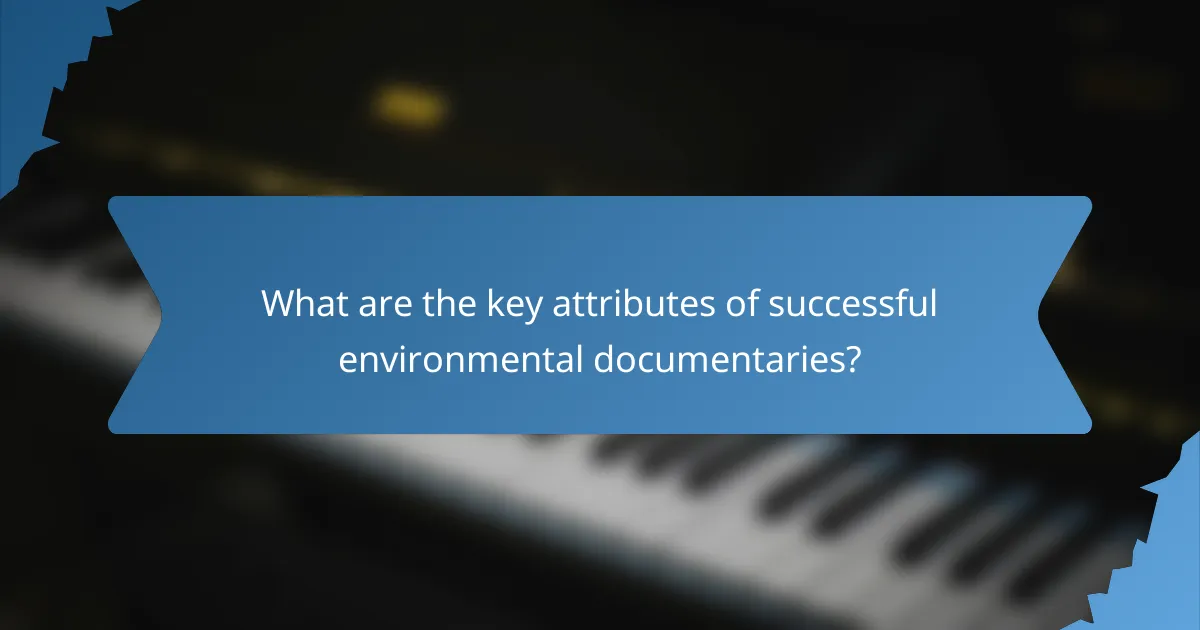
What are the key attributes of successful environmental documentaries?
Successful environmental documentaries typically feature engaging storytelling, strong visual elements, and a clear message that resonates with audiences. These attributes help raise awareness, inspire social change, and encourage viewer engagement with pressing environmental issues.
Compelling narratives and visuals
Compelling narratives are essential for capturing the audience’s attention and fostering emotional connections. A well-structured story often follows a clear arc, presenting challenges and solutions related to environmental issues. Coupled with striking visuals, these narratives can evoke powerful responses and motivate viewers to take action.
Visual elements should include high-quality footage, infographics, and animations that illustrate complex concepts. For example, a documentary on ocean pollution might show before-and-after images of affected areas, making the issue more tangible and relatable for viewers.
Expert interviews and testimonials
Incorporating expert interviews adds credibility and depth to environmental documentaries. Experts can provide insights, data, and context that help viewers understand the significance of the issues presented. Testimonials from individuals affected by environmental challenges can further humanize the narrative, making it more relatable.
When selecting interviewees, consider a diverse range of voices, including scientists, activists, and community members. This variety can enrich the documentary and appeal to a broader audience, enhancing its impact.
Clear calls to action
Effective environmental documentaries often conclude with clear calls to action, guiding viewers on how they can contribute to positive change. These calls can range from simple actions, like reducing plastic use, to more involved efforts, such as supporting specific organizations or participating in local initiatives.
To maximize engagement, provide specific resources or links where viewers can learn more or get involved. For instance, a documentary about climate change might direct viewers to websites where they can sign petitions or donate to relevant causes, fostering a sense of empowerment and community involvement.

What role do film festivals play in promoting environmental documentaries?
Film festivals play a crucial role in promoting environmental documentaries by providing a platform for filmmakers to showcase their work, engage audiences, and foster discussions around pressing environmental issues. These events not only elevate awareness but also facilitate networking and collaboration among industry professionals.
Showcasing diverse perspectives
Film festivals highlight a variety of viewpoints on environmental issues, allowing filmmakers from different backgrounds to present their narratives. This diversity enriches the conversation around sustainability, climate change, and conservation, making it more relatable to a broader audience. For instance, a festival might feature documentaries from indigenous communities that offer unique insights into land stewardship.
Networking opportunities for filmmakers
Festivals serve as valuable networking hubs where filmmakers can connect with industry professionals, potential collaborators, and distributors. These interactions can lead to partnerships that enhance the reach and impact of environmental documentaries. Filmmakers should actively participate in panels and workshops to maximize these opportunities and share their experiences with others in the field.
Audience building and outreach
Film festivals help build dedicated audiences for environmental documentaries by creating a communal space for discussion and engagement. Organizers often incorporate outreach programs, such as educational workshops or Q&A sessions, to deepen audience understanding of the issues presented. Filmmakers can leverage social media and festival platforms to promote their films and engage with viewers before and after screenings, fostering a lasting connection.
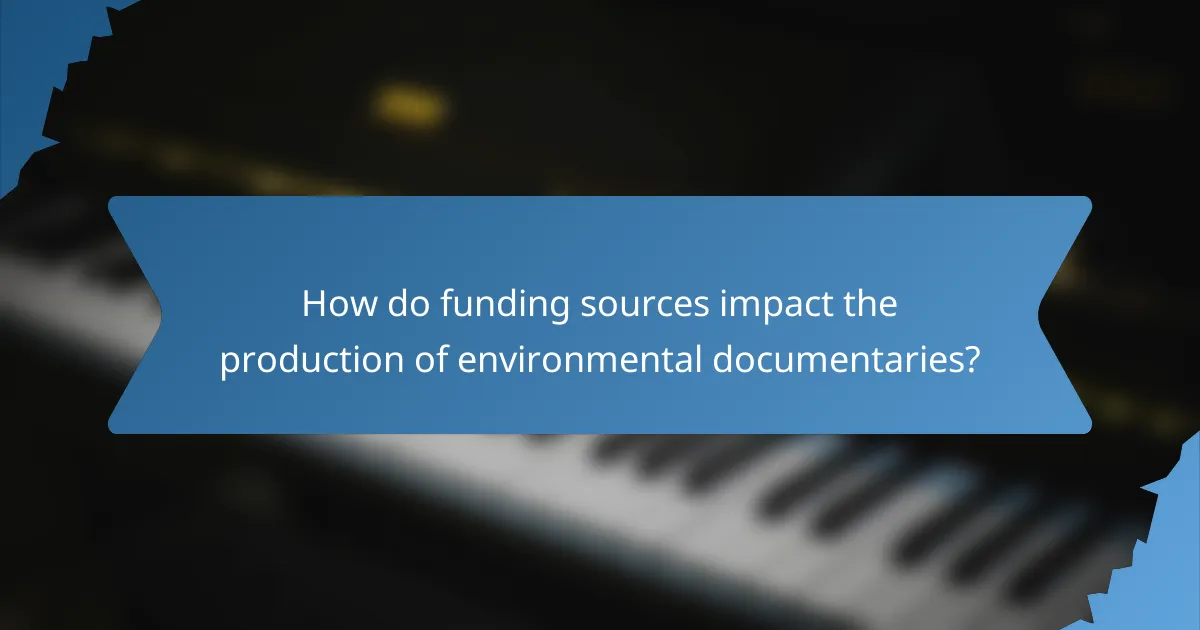
How do funding sources impact the production of environmental documentaries?
Funding sources significantly influence the production of environmental documentaries by determining the scope, quality, and reach of the projects. Diverse funding avenues, such as grants, crowdfunding, and corporate partnerships, each present unique advantages and challenges that can shape the final product.
Grants from environmental organizations
Grants from environmental organizations provide critical financial support for documentary filmmakers focused on ecological issues. These grants often come with specific requirements, such as aligning with the organization’s mission or demonstrating measurable impact on environmental awareness.
Filmmakers should research various environmental foundations and apply for grants that match their project goals. Successful applications typically highlight the documentary’s potential to educate audiences and promote social change.
Crowdfunding success stories
Crowdfunding has emerged as a popular way for filmmakers to finance their environmental documentaries, allowing them to engage directly with their audience. Platforms like Kickstarter and Indiegogo enable creators to raise funds by offering incentives to backers, such as exclusive content or early screenings.
Successful crowdfunding campaigns often leverage social media to build a community around the project. Filmmakers should set realistic funding goals and create compelling narratives to attract potential supporters.
Partnerships with corporate sponsors
Partnerships with corporate sponsors can provide substantial funding for environmental documentaries, but they come with considerations regarding brand alignment and editorial independence. Companies may seek to associate their brand with positive environmental messages, which can enhance the documentary’s visibility.
Filmmakers must carefully evaluate potential sponsors to ensure their values align with the documentary’s message. Transparency with the audience about sponsorship can help maintain credibility and trust.
